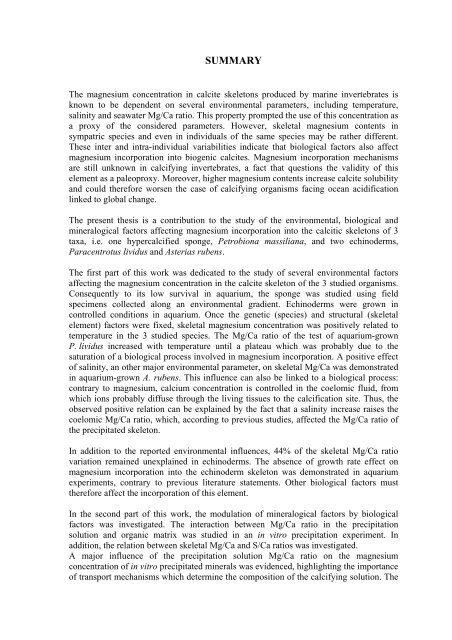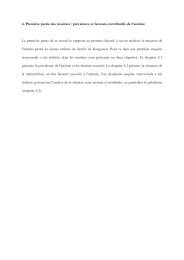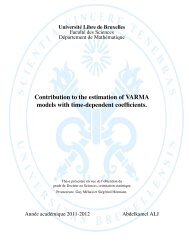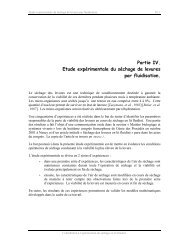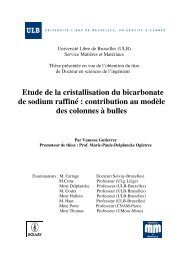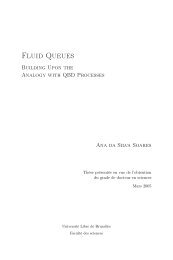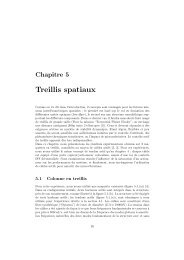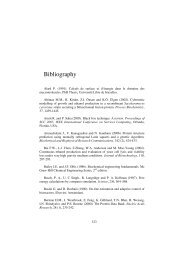Diapositive 1 - de l'Université libre de Bruxelles
Diapositive 1 - de l'Université libre de Bruxelles
Diapositive 1 - de l'Université libre de Bruxelles
Create successful ePaper yourself
Turn your PDF publications into a flip-book with our unique Google optimized e-Paper software.
SUMMARYThe magnesium concentration in calcite skeletons produced by marine invertebrates isknown to be <strong>de</strong>pen<strong>de</strong>nt on several environmental parameters, including temperature,salinity and seawater Mg/Ca ratio. This property prompted the use of this concentration asa proxy of the consi<strong>de</strong>red parameters. However, skeletal magnesium contents insympatric species and even in individuals of the same species may be rather different.These inter and intra-individual variabilities indicate that biological factors also affectmagnesium incorporation into biogenic calcites. Magnesium incorporation mechanismsare still unknown in calcifying invertebrates, a fact that questions the validity of thiselement as a paleoproxy. Moreover, higher magnesium contents increase calcite solubilityand could therefore worsen the case of calcifying organisms facing ocean acidificationlinked to global change.The present thesis is a contribution to the study of the environmental, biological andmineralogical factors affecting magnesium incorporation into the calcitic skeletons of 3taxa, i.e. one hypercalcified sponge, Petrobiona massiliana, and two echino<strong>de</strong>rms,Paracentrotus lividus and Asterias rubens.The first part of this work was <strong>de</strong>dicated to the study of several environmental factorsaffecting the magnesium concentration in the calcite skeleton of the 3 studied organisms.Consequently to its low survival in aquarium, the sponge was studied using fieldspecimens collected along an environmental gradient. Echino<strong>de</strong>rms were grown incontrolled conditions in aquarium. Once the genetic (species) and structural (skeletalelement) factors were fixed, skeletal magnesium concentration was positively related totemperature in the 3 studied species. The Mg/Ca ratio of the test of aquarium-grownP. lividus increased with temperature until a plateau which was probably due to thesaturation of a biological process involved in magnesium incorporation. A positive effectof salinity, an other major environmental parameter, on skeletal Mg/Ca was <strong>de</strong>monstratedin aquarium-grown A. rubens. This influence can also be linked to a biological process:contrary to magnesium, calcium concentration is controlled in the coelomic fluid, fromwhich ions probably diffuse through the living tissues to the calcification site. Thus, theobserved positive relation can be explained by the fact that a salinity increase raises thecoelomic Mg/Ca ratio, which, according to previous studies, affected the Mg/Ca ratio ofthe precipitated skeleton.In addition to the reported environmental influences, 44% of the skeletal Mg/Ca ratiovariation remained unexplained in echino<strong>de</strong>rms. The absence of growth rate effect onmagnesium incorporation into the echino<strong>de</strong>rm skeleton was <strong>de</strong>monstrated in aquariumexperiments, contrary to previous literature statements. Other biological factors musttherefore affect the incorporation of this element.In the second part of this work, the modulation of mineralogical factors by biologicalfactors was investigated. The interaction between Mg/Ca ratio in the precipitationsolution and organic matrix was studied in an in vitro precipitation experiment. Inaddition, the relation between skeletal Mg/Ca and S/Ca ratios was investigated.A major influence of the precipitation solution Mg/Ca ratio on the magnesiumconcentration of in vitro precipitated minerals was evi<strong>de</strong>nced, highlighting the importanceof transport mechanisms which <strong>de</strong>termine the composition of the calcifying solution. The


